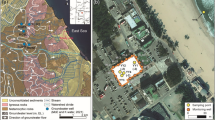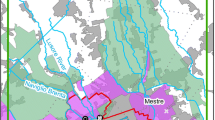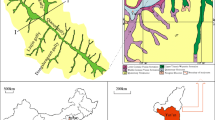Abstract
This study aims to evaluate the impact of road embankment construction on the groundwater system in alluvial aquifers that have excessively used groundwater. A road embankment was constructed across extensive flat alluvial deposits. Laboratory permeability tests demonstrated that the loading by road embankment significantly reduced the permeability of alluvial sediments, creating an impermeable boundary in the groundwater system. The numerical modeling results showed that road embankment acting as an impermeable boundary caused groundwater levels to rise in the upstream area but decline in the downstream area. However, unlike in other upstream areas, there was no noticeable rise in the groundwater level after the embankment construction in the area where the groundwater was in extensive use. The long-term water level monitoring also confirmed no meaningful change in water level during the road embankment construction. This is because the additional decline of the water level due to the decrease in the influence radius of groundwater pumping by the impermeable boundary offsets the increase in the upstream water level. The flow modeling and the water level monitoring showed that the overall impact of the road embankment construction on the groundwater supplies could be insignificant. However, the numerical modeling indicates that the degree of impact varies with the distance from the road embankment. This study implies that the impact of the road embankment construction on the groundwater supplies in the upstream area will depend on the geological and hydraulic settings, which determine the radius of influence, such as the hydraulic property of the alluvial aquifer, pumping rate, the number and location of pumps, etc.
Similar content being viewed by others
References
Attard, G., Winiarski, T., Rossier, Y., and Eisenlohr, L., 2016, Review: impact of underground structures on the flow of urban groundwater. Hydrogeology Journal, 24, 5–19.
Barrett, M., 2018, Mitigation of impacts to groundwater quality from highway runoff in a karst terrain. Transportation Research Record, 2672, 61–67.
Bouwer, H., 1989, The Bouwer and Rice slug test — an update. Groundwater, 27, 304–309.
Bouwer, H. and Rice, R.C., 1976, A slug test for determining hydraulic conductivity of unconfined aquifers with completely or partially penetrating wells. Water Resources Research, 12, 423–428.
COMSOL AB., 2019, COMSOL Multiphysics Reference Manual. Version 5.5, Stockholm, Sweden, 1742 p.
Cooper, H.H.Jr. and Jacob, C.E., 1946, A generalized graphical method for evaluating formation constants and summarizing well-field history. Transactions American Geophysical Union, 27, 526–534.
De Caro, M., Crosta, G.B., and Previati, A., 2020, Modelling the interference of underground structures with groundwater flow and remedial solutions in Milan. Engineering Geology, 272, 105652.
Deveughèle, M., Zokimila, P., and Cojean, R., 2010, Impact of an impervious shallow gallery on groundwater flow. Bulletin of Engineering Geology and the Environment, 69, 143–152.
Earon, R., Olofsson, B., and Renman, G., 2012, Initial effects of a new highway section on soil and groundwater. Water Air and Soil Pollution, 223, 5413–5432.
Font-Capo, J., Pujades, E., Vàzquez-Suñé, E., Carrera, J., Velasco, V., and Montfort, D., 2015, Assessment of the barrier effect caused by underground constructions on porous aquifers with low hydraulic gradient: a case study of the metro construction in Bar-celona, Spain. Engineering Geology, 196, 238–250.
Font-Capó, J., Vázquez-Suñe, E., Carrera, J., Martí, D., Carbonell, R., and Pérez-Estaun, A., 2011, Groundwater inflow prediction in urban tunneling with a tunnel boring machine (TBM). Engineering Geology, 121, 46–54.
Griffiths, D.V., 1984, A chart for estimating the average vertical stress increase in an elastic foundation below a uniformly loaded rectangular area. Canadian Geotechnical Journal, 21, 710–713.
Hong, S.H. and Yoon, U., 1986, Geological survey and map of the Songjung area (scale 1:50,000). Korea Institute of Geoscience and Mineral Resources, Daejeon, 51 p.
Hvorslev, M.J., 1951, Time lag and soil permeability in ground water observations. Bulletin 36, Waterways Experiment Station, Corps of Engineers, U.S. Army, Vicksburg, 50 p.
Kahklen, K. and Moll, J., 1999, Measuring effects of roads on ground-water: five case studies. U.S. Department of Agriculture Forest Service, Technology and Development Program, San Dimas, California, 13 p.
Merrick, N. and Jewell, C., 2003, Modeling of the groundwater impact of a sunken urban motorway in Sydney, Australia. Materials and Geoenvironment, 50, 229–232.
Ministry of Land, Infrastructures and Transport, 2014, Hydrogeological survey report of the Jangseong area, Korea. Ministry of Land, Infrastructures and Transport, Sejong, 228 p.
Mioduszewski, W., 2008, Impact of a road crossing on groundwater level in a river valley. Journal of Water Land Development, 12, 49–58.
Pujades, E., Carrera, J., Vázquez-Suñé, E., Jurado, A., Vilarrasa, V., and Mascuñano-Salvador, E., 2011, Hydraulic characterization of diaphragm walls for cut and cover tunneling. Engineering Geology, 125, 1–10.
Pujades, E., López, A., Carrera, J., Vázquez-Suñé, E., and Jurado, A., 2012, Barrier effect of underground structures on aquifers. Engineering Geology, 145–146, 41–49.
Ricci, G., Enrione, R., and Eusebio, A., 2007, Numerical modelling of the interference between underground structures and aquifers in urban environment. The Turin subway — Line 1. Proceedings of the World Tunnel Congress 2007 and 33rd ITA/AITES Annual General Assembly on Underground Space — The 4th Dimension of Metropolises, Prague, May 5–10, p. 1323–1329.
Smith, C.C., Cripps, J.C., and Wymer, M.J., 1999, Permeability of compacted colliery spoil — a parametric study. Engineering Geology, 53, 187–193.
Tsunokawa, K. and Hoban, C., 1997, Roads and the environment: a handbook. World Bank Technical Paper No. 376, The World Bank, Washington, D.C., p. 225.
Vaughan, P.R., 1989, Non-linearity in seepage problems — theory and field observation. In: De Mello Volume. Editora Edgard Blucher Ltda, Sao Paulo, p. 501–516.
Vilarrasa, V., Carrera, J., Jurado, A., Pujades, E., and Vázquez-Sunéa, E., 2011, A methodology for characterizing the hydraulic effectiveness of an annular low-permeability barrier. Engineering Geology, 120, 68–80.
Yihdego, Y., Danis, C., and Paffard, A., 2017, Groundwater engineering in an environmentally sensitive urban area: assessment, landuse change/infrastructure impacts and mitigation measures. Hydrology, 4, 37.
Acknowledgments
The authors thank the Korean Expressway Corporation and GS E&C for providing manually monitored water level data, borehole logging data, and alluvial samples.
Author information
Authors and Affiliations
Corresponding author
Additional information
Publisher’s Note
Springer Nature remains neutral with regard to jurisdictional claims in published maps and institutional affiliations.
Rights and permissions
About this article
Cite this article
Kim, D., Cha, B.G. & Yeo, I.W. Impact of road embankment construction on groundwater system in alluvial aquifers. Geosci J 27, 89–99 (2023). https://doi.org/10.1007/s12303-022-0024-z
Received:
Accepted:
Published:
Issue Date:
DOI: https://doi.org/10.1007/s12303-022-0024-z




